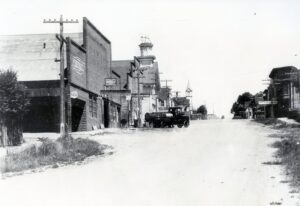
Did you ever go past a house in Mendocino and wonder “What kind of a story could that building tell? How old is it? Who built it? Was it always a store?” The answers to those questions are in the archives of the Kelley House Museum.
Before the town became a historic preservation district in 1973, every plot was catalogued, mapped and inventoried by Mendocino Historical Research, which became the Kelley House Museum. It was like writing a biography for a chunk of land. Forty-plus years later, ownership and uses continue to change and our understanding of the history of the buildings keeps growing.
The various historical structure inventories the Museum has created provide snapshots of the buildings and can give you the basic specs of a structure – its parcel number, street address(es), the dimensions of the plot of land on which it sits, its historical name, the name of the owners, and how it was used at the time of the inventory. Architectural descriptions tell you about the style and construction date.
Take the simple Joseph Lawrence Dias House at 45342 Ukiah Street. Built around 1884 on a 40’ by 80’ lot, it is described in the inventories as a simple gable-roofed house with a developed attic. Redwood shiplap siding covers it with shingles on the south face. The roof at the time of the inventory was composition shingles. The front façade’s original windows have been replaced with a large picture window.
But the Kelley House has another way to document properties – our Family Files. There are hundreds of family names in the file cabinets down in the vault. We know William H. Kelley sold this plot to J. C. Dias on July 24, 1883. We know Maria (Lawrence) Dias lived out her life there, though the rest of the family moved to Fort Bragg. We know that Joe Dias was a laborer at the Mendocino Lumber Company from 1884-1885. Family files and other research materials often fill in missing information about a structure and the people who lived there.
Each inventory made over the years has added to our understanding of the town. Some mention a building’s use (tinsmith shop, jewelry store, photography gallery) as well as the basic data. Notes say, “open lot” or “vacant and deteriorated” for buildings that have disappeared since the previous inventories were made. Lucky survivors are now dwellings, restaurants, studios, offices and mercantile establishments.
It’s the tidbits of information on buildings that I find fascinating. The Mendocino Hotel started in 1878 as Temperance House for boarders who didn’t want to be sleep at the hotels that served booze. It was so popular a second story was added.
The Blue Door Inn, previously the Whitegate Inn, on the southeast corner of Howard and Ukiah streets, was inhabited from the 1880s into the 1980s by many doctors and their families, and so it is often referred to as the “House of Doctors.”
The Frank Brown House at 45100 Ukiah Street became a “female boarding house,” a polite way of saying brothel. There was even a murder there.
Did you know that before Bank of America and then Out of This World existed on Main and Kasten Streets, there was a Chinese Laundry on that corner, run by a man named Chung Kow?
The popular watering hole Dick’s Place at 45070 Main Street was built as dentist Walter Hodghead’s office in 1902.
According to Karen McGrath, the director and curator of the Museum, recent research continues to reveal more details about the town’s people and places. Consider the big building located on the southwest corner of Ukiah and Lansing Street, across from the Savings Bank building where Rainsong clothing store is now located. William H. Kelley started building this one-story 40-foot by 90-foot building in 1886 as a dance hall and skating rink. It was known then as Kaze Hall (K’s Hall, as in Kelley’s Hall).
But who would have guessed how many types of businesses have operated there since then: a saloon, a restaurant, a pool room, a movie house, a gymnasium, and in the 1920s a confectionary run by the Hee Family.
Then around 1950, Kelley’s daughter, Daisy MacCallum, completely renovated it for the Mendocino Study Club. Renaming it Kellieowen Hall for her parents (her mother’s family name was Owen), it was for many years the home of the community library and a meeting place the Club rented out. Corners of the Mouth food cooperative operated there before relocating to its present location, and it’s been a clothing store under different ownerships since the late 1970s. What a history!
If you own a structure in Mendocino, you can discover its story in the Kelley House archives. If you want to know the name for the gingerbread fretwork on the MacCallum House, you’ll find that there. And if you just want a photo of your favorite old house, Kelley House can do that, too.
The Kelley House Research Office, located at 45007 Albion Street in Mendocino, is open from 1:00 pm to 4:00 pm Monday through Friday. Customized research is available. It’s best to call 937-5791 to make an appointment. Or contact curator@kelleyhousemuseum.org